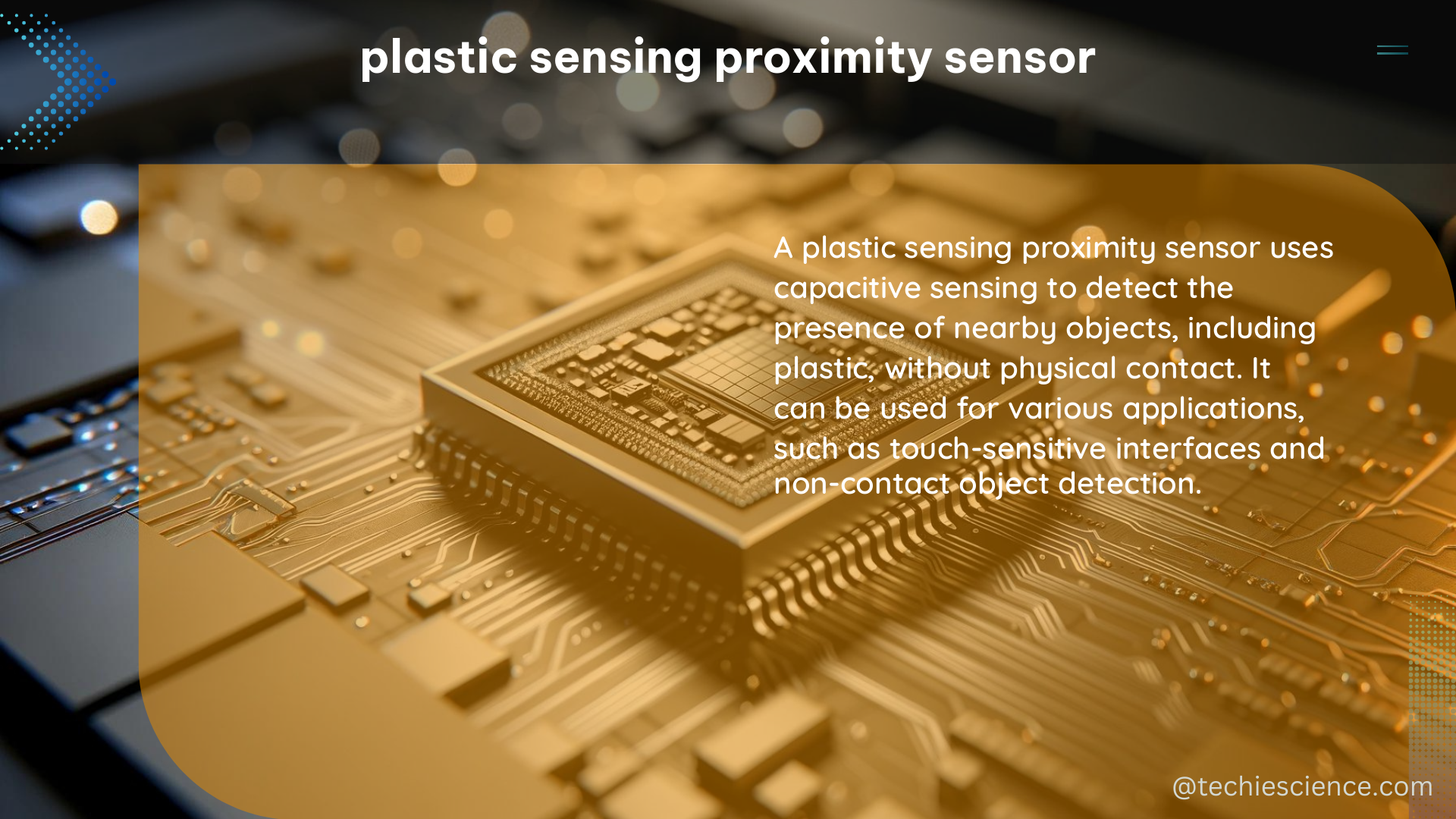Plastic sensing proximity sensors are versatile devices that utilize the principle of capacitance to detect the presence and measure the distance of plastic objects. These sensors work by monitoring the changes in capacitance between a sensing electrode and a grounded plate when a plastic object approaches the sensor. Mastering the intricacies of these sensors can open up a world of possibilities for DIY enthusiasts and researchers alike.
Understanding the Fundamentals of Plastic Sensing Proximity Sensors
Plastic sensing proximity sensors rely on the unique dielectric properties of plastic materials to detect their presence. The relative dielectric constant of a plastic object, which can range from 2 to 4 depending on the specific material, plays a crucial role in the sensor’s response. When a plastic object comes within the sensor’s detection range, it alters the electric field between the sensing electrode and the grounded plate, causing a change in the measured capacitance.
The sensitivity and accuracy of these sensors are influenced by several factors, including:
-
Sensor Design: The geometry, size, and configuration of the sensing electrode and the grounded plate can significantly impact the sensor’s performance. Optimizing these parameters can enhance the sensor’s detection range, resolution, and sensitivity.
-
Plastic Object Properties: The thickness, shape, and surface characteristics of the plastic object can affect the sensor’s response. Thinner and more irregular objects may be more challenging to detect accurately.
-
Environmental Conditions: The surrounding environment, such as temperature, humidity, and the presence of other conductive materials, can influence the sensor’s performance. Proper shielding and calibration are essential to maintain consistent and reliable measurements.
Quantifying the Performance of Plastic Sensing Proximity Sensors

Numerous studies have been conducted to evaluate the capabilities of plastic sensing proximity sensors. Here are some key data points and findings:
-
Microplastic Detection: A study using a compact holographic microscope reported a detection limit of 10 μm and a counting accuracy of 95% for microplastic particles in flowing water samples.
-
Plastic Waste Detection: A prototype optical sensor for the detection of plastic waste in water bodies was able to detect plastic particles as small as 1 mm with a detection accuracy of 95%.
-
Material Differentiation: A research paper described a method for differentiating recyclable materials like paper and plastic using a capacitance proximity sensor. The sensor was able to accurately identify the material type with a high degree of reliability.
-
Sensor Sensitivity: The sensitivity of plastic sensing proximity sensors can be influenced by the dielectric constant of the plastic material. For example, materials with higher dielectric constants, such as polyvinyl chloride (PVC) and polycarbonate (PC), typically produce stronger sensor signals compared to materials with lower dielectric constants, like polyethylene (PE) and polypropylene (PP).
Building and Calibrating Plastic Sensing Proximity Sensors
For DIY enthusiasts, there are several resources available to help you build and calibrate your own plastic sensing proximity sensors. One such resource is a research paper that provides detailed instructions on constructing a capacitance proximity sensor for differentiating recyclable materials.
The key steps involved in building a plastic sensing proximity sensor include:
-
Sensor Design: Determine the optimal geometry and configuration of the sensing electrode and the grounded plate based on your specific application requirements.
-
Circuit Design: Develop the electronic circuit that will measure the changes in capacitance and convert them into meaningful data.
-
Calibration: Establish a calibration process to ensure accurate and consistent measurements across different plastic materials and environmental conditions.
-
Data Analysis: Implement algorithms or software to interpret the sensor’s output data and provide useful information, such as the presence, distance, and type of plastic object.
To further enhance the performance of your plastic sensing proximity sensor, you can explore advanced techniques like machine learning-based classification algorithms, which can help differentiate between various plastic materials with a high degree of accuracy.
Practical Applications of Plastic Sensing Proximity Sensors
Plastic sensing proximity sensors have a wide range of applications, including:
-
Recycling and Waste Management: These sensors can be used to identify and sort different types of plastic materials in recycling facilities, improving the efficiency and accuracy of the recycling process.
-
Environmental Monitoring: Plastic sensing proximity sensors can be deployed in water bodies, soil, and other environments to detect and quantify the presence of plastic pollution, aiding in environmental conservation efforts.
-
Industrial Automation: These sensors can be integrated into manufacturing processes to monitor the presence and positioning of plastic components, enabling more precise control and quality assurance.
-
Robotics and Automation: Plastic sensing proximity sensors can be used in robotic systems to detect and interact with plastic objects, enabling more advanced and versatile robotic applications.
-
Smart Packaging: Integrating plastic sensing proximity sensors into packaging materials can provide real-time information about the integrity and status of the packaged products, improving supply chain management and consumer safety.
By mastering the intricacies of plastic sensing proximity sensors, DIY enthusiasts and researchers can unlock a world of possibilities, contributing to a more sustainable and efficient future.
References:
- A prototype of a portable optical sensor for the detection of microplastics in water bodies, Science Direct, 2019.
- Potential of Optical Spaceborne Sensors for the Differentiation of Plastics in the Environment, MDPI, 2023.
- Flow-Through Quantification of Microplastics Using Impedance Spectroscopy, ACS Sensors, 2021.
- Why can’t Capacitive Sensors detect Plastic PET Bottles?, Reddit, 2021.
- Application of Capacitance Proximity Sensor for the Identification of Paper and Plastic from Recycling Materials, ResearchGate, 2017.

The lambdageeks.com Core SME Team is a group of experienced subject matter experts from diverse scientific and technical fields including Physics, Chemistry, Technology,Electronics & Electrical Engineering, Automotive, Mechanical Engineering. Our team collaborates to create high-quality, well-researched articles on a wide range of science and technology topics for the lambdageeks.com website.
All Our Senior SME are having more than 7 Years of experience in the respective fields . They are either Working Industry Professionals or assocaited With different Universities. Refer Our Authors Page to get to know About our Core SMEs.